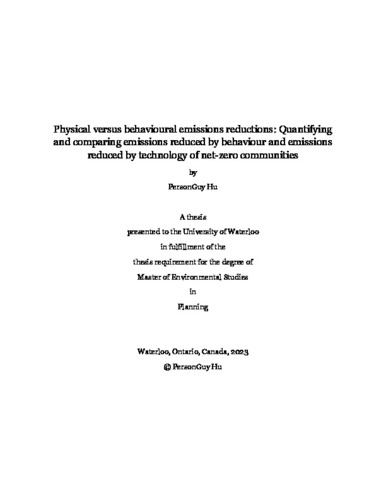| dc.contributor.author | Hu, PersonGuy | |
| dc.date.accessioned | 2024-01-04 14:10:39 (GMT) | |
| dc.date.available | 2024-01-04 14:10:39 (GMT) | |
| dc.date.issued | 2024-01-04 | |
| dc.date.submitted | 2023-12-07 | |
| dc.identifier.uri | http://hdl.handle.net/10012/20206 | |
| dc.description.abstract | Modern climate change research calls for more diverse and creative solutions past simply improving technology; there is not one solution to climate change. A multidisciplinary field like planning can affect both physical changes in a city or behaviour changes in people to reduce greenhouse gas emissions. Despite these considerations, behavioural emissions reductions remain an underexplored topic of literature, especially in terms of emission quantification. Without this information, planners cannot make the most informed and resource efficient policy decisions to combat climate change. This thesis fills this literature gap by quantifying behavioural emissions reductions and comparing them to the best-case scenario for physical emissions, net-zero communities, in the context of Ontario’s first, recently completed, net-zero community located in London, Ontario. This thesis also begins to explore relationships and patterns between sources of behavioural emissions reductions and how they can compound into greater reductions. Within the study area, net-zero homes produced 6.89 fewer tonnes of CO2e/year compared to the average home, 67.5% of which were physical emissions reductions and 32.5% of were behavioural. Residents here generally improved few behaviours to a large magnitude rather than improving many/all behaviours to a small magnitude. While no specific behaviour patterns were identified, the there was evidence in favour of patterns existing, which could by identified with a larger sample. Overall, while behavioural emissions reductions were less effective than physical, they can be implemented both concurrently and instead of physical when necessary. There is also potential for behavioural emissions reductions to be more effective than physical given the right context and if behavioural patterns are used to their fullest. | en |
| dc.language.iso | en | en |
| dc.publisher | University of Waterloo | en |
| dc.subject | climate chage | en |
| dc.subject | planning | en |
| dc.subject | ghg emissions | en |
| dc.subject | behaviour | en |
| dc.subject | net-zero community | en |
| dc.subject | carbon accounting | en |
| dc.title | Physical versus behavioural emissions reductions: Quantifying and comparing emissions reduced by behaviour and emissions reduced by technology of net-zero communities | en |
| dc.type | Master Thesis | en |
| dc.pending | false | |
| uws-etd.degree.department | School of Planning | en |
| uws-etd.degree.discipline | Planning | en |
| uws-etd.degree.grantor | University of Waterloo | en |
| uws-etd.degree | Master of Environmental Studies | en |
| uws-etd.embargo.terms | 0 | en |
| uws.contributor.advisor | Pittman, Jeremy | |
| uws.contributor.affiliation1 | Faculty of Environment | en |
| uws.published.city | Waterloo | en |
| uws.published.country | Canada | en |
| uws.published.province | Ontario | en |
| uws.typeOfResource | Text | en |
| uws.peerReviewStatus | Unreviewed | en |
| uws.scholarLevel | Graduate | en |

